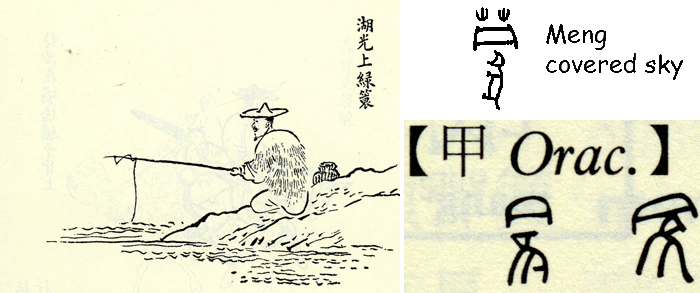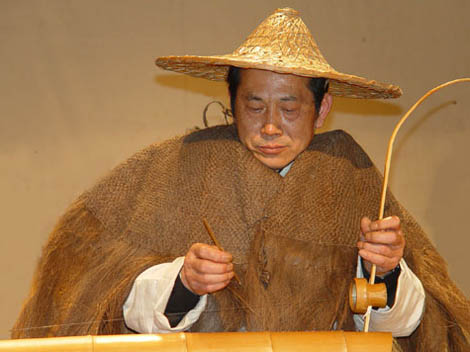I Ching, Yijing or Zhou Yi
"Oracle of the moon": © 2000 LiSe
 Yi Jing, Oracle of the Moon
Yi Jing, Oracle of the Moon


Hex.3 and 4: youth
Hex.3 ZHUN, The spark of beginnings
  |
Ban Xiang Hu Gua Qian Gua Jiao Gua Pang Tong Gua |
Trigrams thunder-water
Nuclear 23 Inverse 4 Reverse 40 Opposite/complementary 50 |

Pictures at top: ZHUN1, the ancient character and its parts.
Zhun1 is a picture of a sprouting seedling. 1: Two other forms of the same character.
ZHUN1 : to sprout, difficult, obstacle, hard and stingy. Pronounced TUN2: pair of shoulder blades, one of a pair, greatly, humble, perfect, generous, well-to-do (the meanings have to do with the pair of shoulder blades: both or all, no exception)
TUN2: accumulate, to bring together soldiers, to station (an army), to stockpile, village; visible, to be there.
Interchangeable with CHUN1: spring, vitality, sensuality, youth. Later it was also used instead of chun2 (chun1 + radical silk) ‘pure, faultless’, because this character was taboo being an emperor’s name.
The characters at left: words or compounds with ZHUN1
1 (silk+sprout) pure, simple
2 (sprout gather) assemble; collect
3 (sprout son) village
4 (sprout soldier) station troops
5 (sprout field) (hist.) station garrisons to grow own food
6 (sprout cultivate) station troops to open up wasteland
7 (sprout grain+provisions) store up grain
8 (sprout garrison) garrison, defend
'Garrison' in a meaning of gathering/concentrating/heaping up/growing makes most sense. Sprouts: like a newly planted field, rather than one single sprout.
ZHUN, hexagram 3. When heaven and earth meet, new things will come about. The pattern of heaven, the energy of earth, they are the base of every creation.
Zhun is not just one single seedling, it is the image of all seedlings, of growth along a pattern, of the blueprint of life. When the pattern and the energy meet, life accumulates, the world fills with creatures.
In man it is the vitality which brings about health and stamina. In his actions it brings drive.
Hex.4 MENG, Not knowing
  |
Ban Xiang Hu Gua Qian Gua Jiao Gua Pang Tong Gua |
Trigrams water-thunder Nuclear 24 Inverse 3 Reverse 39 Opposite/complementary 49 |

Pictures at top: MENG2, the ancient character and its parts.
MENG2: a pig shi3 (3), covered mi2 or mao4 (2) with or by plants cao1 (1). According to Wang HongYuan: hunters disguised in animal skins. The pig is probably an image of another animal. Maybe a tiger, the two images resemble each other and are easily confused.
MENG2: to cover, ignorant (child), illiterate, immature, inexperienced, benighted; receive; meet with; a darkened mind, a cloudy sky, unconscious, senseless. MENG1: cheat, deceive, make wild guess.
The characters at left: words or compounds with MENG2
1 (obscure obscure) drizzly; misty
2 (obscure medicine) narcotic; anaesthetic
3 (open-up obscure) initiate children to learning
4 (obscure leader) teacher who first introduces student to certain field, teacher of young children
5 (obscure obscure shine) at first light; hazily bright
6 (water+obscure) mist, drizzling rain
7 (eye+obscure) dim-sighted, blind; stupid
8 (moon+obscure) dim moonlight; obscure
1, 6, and 7 are all etymologically the same words.
The most obvious meanings: misty, unclear, vague.
MENG, hexagram 4. Misty. Everyone has an ocean inside, a huge reservoir of hidden possibilities. The ignorant pupil whose wisdom is his eagerness and openness to learn. The adept who knows a lot but sees so much more he still is far from knowing. The sage, who is a sage because he knows how little he knows.
Meng can also apply to a simple situation where one fails to see the obvious. To refuse or to be unable to open oneself to learning.
Youth is made for learning, it is the total openness for everything, good or bad.
Every being is an individual, but deep inside he is, or has, part of the primeval ocean of wisdom and strength. A good teacher only opens the entrance to this ocean, without imposing any views. A good pupil searches for a valuable teacher, and then accepts all without narrowing it to personal ideas. Children are born with the ability to complete openness, it disappears when they grow older and start to discern. A good teacher teaches by being an example.
But then there is something else:
| Harmen in a discussion in Clarity "The oracle bone character does not contain the 'grass' radical which was added in later centuries. |
 |
Second, the part that is normally recognized as 'pig' is nowadays regarded as a picture of a tiger. According to Liu Xing-long 劉興隆, Xinbian Jiaguwen Zidian 新編甲骨文字典, the meaning was originally "勇士偽裝, 披戴虎皮", "pretend to be brave, to wear a tiger's skin". But if this was really its meaning is not at all certain. Liu cites an inscription which he reads as the description of a person who hides his strength and abilities to be able to attack the enemy and make prisoners (p. 34)." In other words, with meng 蒙 you are not ignorant, you pretend to be ignorant so you can exercise your capabilities when the time is right. At least this seems to be one of the oldest meanings of meng. (picture at right from the Xinbian Jiaguwen Zidian: a. tiger - b. pig) According to 新編甲骨文 Meng means slyly attacking one's enemy, like a hidden tiger. There is a lot of contradictory info. Firstly, there is no Meng as we know it on OB. There is without the grass radical. Many dictionaries claim this is the precursor of meng, but it is not clear on what this is based. The meanings of meng as we know it now don't apply to the one without the grass radical. About its meanings, dictionaries digress. According to Jiaguwen Zidian the animal component is 隹, a kind of bird, maybe a pigeon. |
 |
Meaning of the character as a whole: fog. In the examples of inscriptions that seems very plausible. But in other dictionaries there is no such meaning to be found. The fundamental meaning is 'covering, secretly, slyly'. The 'discovery' that it is about a tiger comes from Hu Houxuan 胡厚宣, who also claims 'a soldier who attacks the enemy in disguise' to be the old meaning of meng. That strikes me as strange, because meng does not figure in OB characters and in later texts it did not have that meaning as far as I know. Maybe this meaning of 'concealed' is connected with meng because it is often used as component in characters with a tenor to 'hidden' in their meanings.
A few from Wenlin:
朦 [méng] 朦胧 ménglóng dim moonlight; obscure
濛 [méng] mist, drizzling rain
矇 [méng] dimsighted, blind; stupid
幪 [méng] 幪幪 méngméng lush; 帡幪 píngméng shelter
曚 [méng] the sun below the horizon
霥 [mèng] (=濛) drizzling, fine rain; mist
靀 [lèi] [méng] (Unihan:) drizzling, fine rain; mist
The question is in how far this is relevant to meng in the Yijing. I think the key lies in the different components in which meng is used: 童蒙, 發蒙, 包蒙, 困蒙 en 擊蒙 (the combinations in the Yi-lines). My guess is, that with the help of those you can reveal the meaning of meng.
LiSe: And finally a weird idea... The character meng on Oracle Bones means "covered sky". Below are two examples of how it looked back then. What if it is a drawing of a person in a raincoat? These coats of grass were very common, even nowadays there are still some regions where farmers or fishermen wear them. The fisherman in the picture has a small one, I have seen pictures where they looked like thatched roofs, but raincoat-size.


Found here on internet: People in ancient times also wore the wind coat and raincoat against wind, rain and snow when staying out. The raincoat appeared earlier than the wind coat. As recorded in historical literatures, people in the Zhou Dynasty had begun the use of the raincoat and the earliest raincoat was made of straws and thus referred to as “coir raincoat".
The raincoat was "invented later than the oracle bones" acording to records. But before that time, I think people already covered themselves against rain with grass or straw.